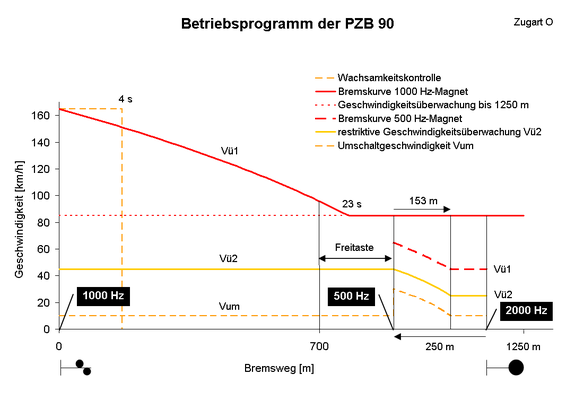
Cab signaling is a railway safety system that communicates track status and condition information to the cab, crew compartment or driver's compartment of a locomotive, railcar or multiple unit. The information is continually updated giving an easy to read display to the train driver or engine driver.

Automatische TreinBeïnvloeding or ATB is a Dutch train protection system first developed in the 1950s. Its installation was spurred by the Harmelen train disaster of 1962.

Linienzugbeeinflussung is a cab signalling and train protection system used on selected German and Austrian railway lines as well as on the AVE and some commuter rail lines in Spain. The system was mandatory where trains were allowed to exceed speeds of 160 km/h (99 mph) in Germany and 220 km/h (140 mph) in Spain. It is also used on some slower railway and urban rapid transit lines to increase capacity. The German Linienzugbeeinflussung translates to continuous train control, literally: linear train influencing. It is also called linienförmige Zugbeeinflussung.

Transmission Voie-Machine is a form of in-cab signalling originally deployed in France and is mainly used on high-speed railway lines. TVM-300 was the first version, followed by TVM-430.
Railway signals in Germany are regulated by the Eisenbahn-Signalordnung. There are several signalling systems in use, including the traditional H/V (Hauptsignal/Vorsignal) system.
A train protection system is a railway technical installation to ensure safe operation in the event of human error.
Sistema di Controllo della Marcia del Treno (SCMT) is a discontinuous train cab signalling system used in Italy. It shares many features with the Ripetizione Segnali (RS) system, the two systems co-existing and working together. The main purpose of SCMT is to control the respect of the speed limit imposed by the signal aspect and the line condition.

Advanced Civil Speed Enforcement System (ACSES) is a positive train control cab signaling system developed by Alstom. The system is designed to prevent train-to-train collisions, protect against overspeed, and protect work crews with temporary speed restrictions. The information about permanent and temporary speed restrictions is transmitted to the train by transponders (Balises) lying in the track, coded track circuits and digital radio. It was installed beginning in 2000 on all of Amtrak's Northeast Corridor between Washington and Boston, and has been fully active since December 2015, a few months after the 2015 Philadelphia train derailment which it would have prevented.
EBICab is a trademark registered by Alstom for the equipment on board a train used as a part of an Automatic Train Control system. Three different families exist, which are technically unrelated.
Belgian railway signalling is the signalling in effect on the Belgian rail network currently operated by Infrabel.

LS is a cab signalling and train protection system used on the main lines of Czech and Slovak railways. This system continuously transmits and shows a signal aspect of the next main signal in the driver's cabin while also periodically checking the driver's vigilance when their attention is required.

ALSN is a train control system used widely on the main lines of the ex-Soviet states. It uses modulated pulses inducted into rails similar to the Italian RS4 Codici and American Pulse Code Cab Signaling. On high-speed lines the variant ALS-EN (АЛС-ЕН) is used which takes advantage of a double phase difference modulation of the carrier wave.

The Rüsselsheim train disaster occurred on February 2, 1990, on the Main Railway near the Rüsselsheim station in West Germany. With 17 persons killed and 145 injured the train collision is amongst the most serious in rapid transit.
The Polish (PKP) railway signalling system provides a complex outlook of traffic situations, yet is quite easy to understand. Signals can be divided into following categories:

Anuncio de Señales y Frenado Automático is an Automatic Train Protection system widely deployed on the Spanish rail network. It consists of a mechanism that stops a train if the driver does not properly heed signals.

The ÖBB Classes 1044 and 1144 are four-axle electric universal locomotives that were developed by Simmering-Graz-Pauker and built in Graz. When initially deployed, they were used throughout Austria in front of all types of trains and were a milestone in locomotive construction. At the time they were put into service, they were the most powerful electric locomotives in the world and were ÖBB's showpiece until the 1016 and 1116 series were purchased.
The intermittent inductive automatic train stop is a train protection system used in North American mainline railroad and rapid transit systems. It makes use of magnetic reluctance to trigger a passing train to take some sort of action. The system was developed in the 1920s by the General Railway Signal Company as an improvement on existing mechanical train stop systems and saw limited adoption before being overtaken by more advanced cab signaling and automatic train control systems. The system remains in use after having been introduced in the 1920s.

The train protection system Geschwindigkeitsüberwachung Neigetechnik enables to rise the speed of tilting trains until 30 % above the limits for conventional trains. It is installed on numerous lines in Germany along with the traditional Punktförmige Zugbeeinflussung (PZB) intermittent signalling system.

The ZUB 1xx system is a family of train protection systems produced by Siemens. Its ZUB balises were deployed in the ZUB 121 train protection system in the Swiss railway network, in the ZUB 122 tilting control system in the German railway network, and in the ZUB 123 train protection system in the Danish railway network. Some of these were adapted for other railway lines before the next generation ZUB 2xx family was introduced which is based on Eurobalises - the earlier ZUB balises are not compatible with those.


















